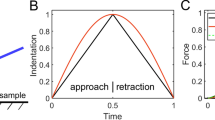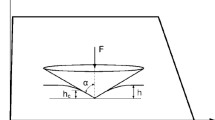Abstract
The evaluation of viscoelastic characteristics by an indentation test is required in order to separate the viscoelastic deformation and plastic deformation from the measured penetration depth. In this study, a multicycle indentation test is performed in order to separate these deformations and to evaluate the viscoelastic characteristics of acrylonitrile butadiene styrene (ABS) and polybutylene terephthalate (PBT). In the multicycle indentation test, two or more indentation tests are conducted at the same specimen position. After the first cycle, the indentation test is performed on the impression; thus, an evaluation formula for obtaining the viscoelastic characteristics is proposed, and the validity of this formula is confirmed by finite element analysis. As a result, the evaluated creep compliances of both materials are close the value evaluated by tensile testing. Therefore, it is concluded that the proposed method is applicable to the evaluation of viscoelastic characteristics.











Similar content being viewed by others
References
Fischer-Cripps AC (2004) Nanoindentation, 2nd edn. Springer, Berlin
Dao M, Chollacoop N, Van Vliet KJ, Venkatesh TA, Suresh S (2001) Computational modeling of the forward and reverse problems in instrumented sharp indentation. Acta Mater 49(19):3899–3918
Bucaille JJ, Stauss S, Felder E, Michler J (2003) Determination of plastic properties of metals by instrumented indentation using different sharp indenters. Acta Mater 51(6):1663–1678
Sneddon IN (1965) The relation between load and penetration in the axisymmetric Boussinesq problem for a punch of arbitrary profile. Int J Eng Sci 3:47–57
Lee EH, Radok JRM (1960) The contact problem for viscoelastic bodies. J Appl Mech 27:438–444
Ting TCT (1966) The contact stresses between a rigid indenter and a viscoelastic half-space. J Appl Mech 33:845–854
Christensen RM (2003) Theory of Viscoelastitcity, 2nd edn. Dover, Mineola
Lu H, Wang B, Ma J, Huang G, Viswanathan H (2003) Measurement of creep compliance of solid polymers by nanoindentation. Mech Time-Depend Mater 7:189–207
Huang G, Lu H (2006) Measurement of Young’s relaxation modulus using nanoindentation. Mech Time-Depend Mater 10:229–243
Braunsmann C, Proksch R, Revenko I, Schäffer TE (2014) Creep compliance mapping by atomic force microscopy. Polymer 55:219–225
Oyen ML (2006) Analytical techniques for indentation of viscoelastic materials. Philos Mag 86:5625–5641
Menčík J, He LH, Němeček J (2011) Characterization of viscoelastic-plastic properties of solid polymers by instrumented indentation. Polym Test 30:101–109
Peng G, Ma Y, Feng Y, Huan Y, Qin C, Zhang T (2015) Nanoindentation creep of nonlinear viscoelastic polypropylene. Polym Test 43:38–43
Sakaue K, Okazaki S, Ogawa T (2011) Indentation technique for evaluation of master curve of creep compliance. Exp Tech 35(5):16–22
Sakaue K, Isawa T, Ogawa T, Yoshimoto T (2012) Evaluation of viscoelastic characteristics of short-fiber reinforced composite by indentation method. Exp Mech 52:1003–1008
Stan F, Fetecau C (2013) Characterization of viscoelastic properties of molybdenum disulphide filled polyamide by indentation. Mech Time-Depend Mater 17:205–221
Pöhl F, Huth S, Theisen W (2014) Indentation of self-similar indenters: An FEM-assisted energy-based analysis. J Mech Phys Sol 66:32–41
Zaroulis JM, Boyce MC (1997) Temperature, strain rate, and strain state dependence of the evolution in mechanical behaviour structure of poly(ethylene terephthalate) with finite strain deformation. Polymer 38(6):1303–1315
Author information
Authors and Affiliations
Corresponding author
Rights and permissions
About this article
Cite this article
Kato, K., Kishibe, S., Sakaue, K. et al. Multicycle Indentation for Evaluation of Polymer Material Viscoelastic Characteristics. Exp Mech 58, 759–766 (2018). https://doi.org/10.1007/s11340-018-0376-5
Received:
Accepted:
Published:
Issue Date:
DOI: https://doi.org/10.1007/s11340-018-0376-5




